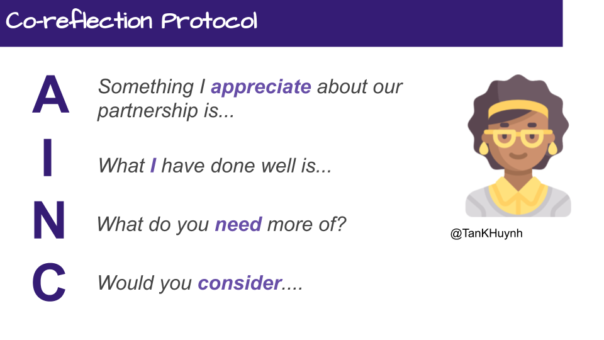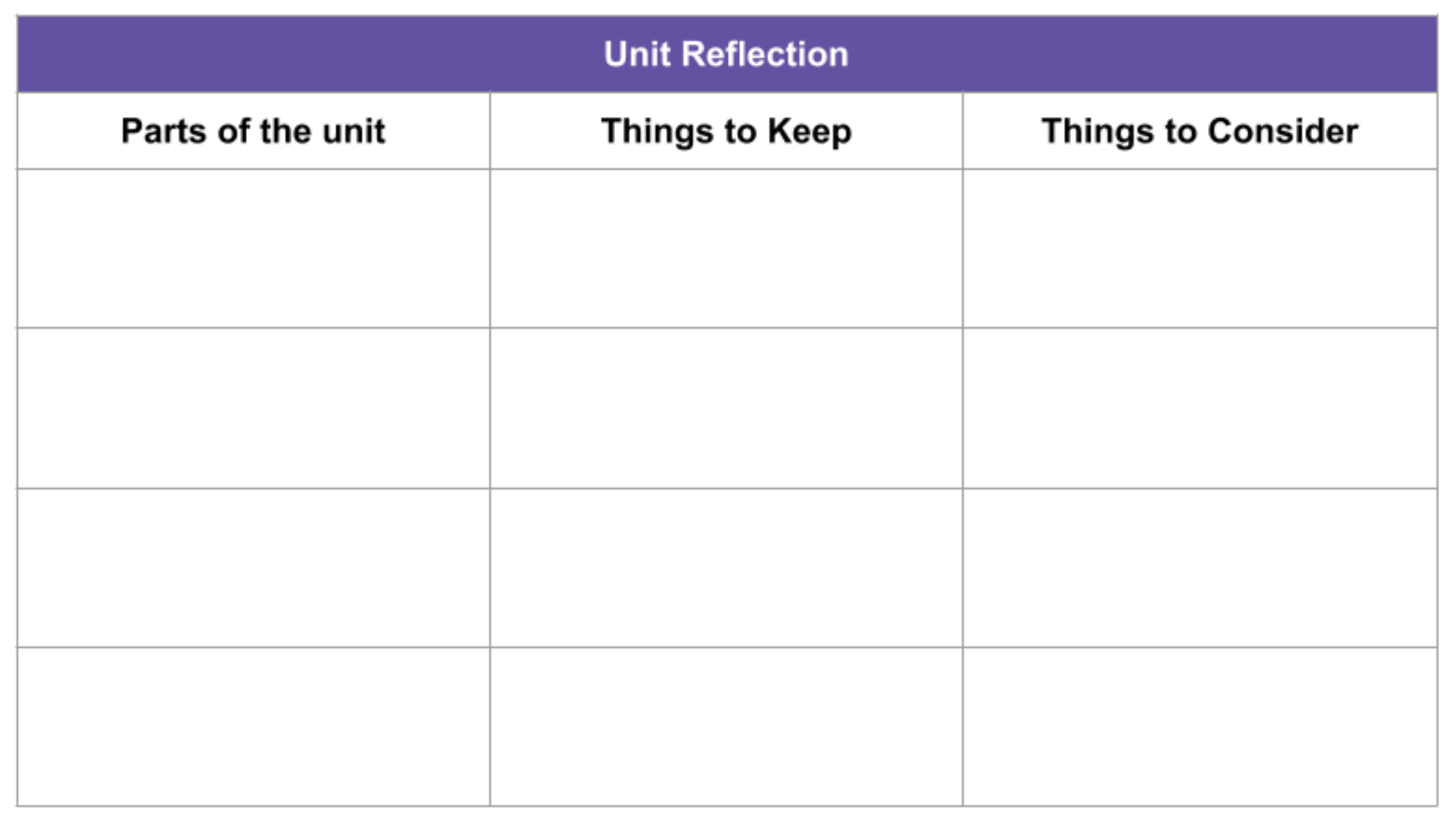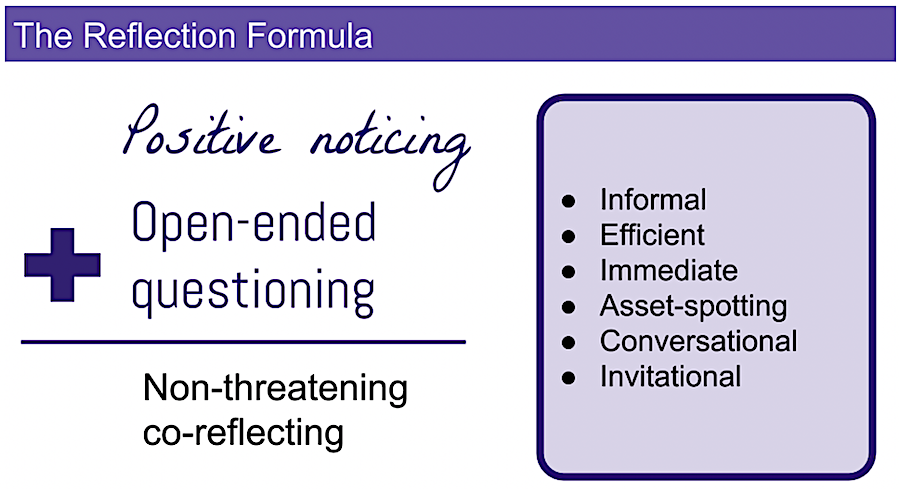Up Your Co-Teaching by Adding Co-Reflecting
A MiddleWeb Blog

If getting feedback from students is an effective practice, why not ask for feedback from our teaching partners? Andrea Honigsfeld and Maria Dove recommend we do this. Their Collaborative Teaching Cycle consists of co-planning, co-teaching, co-assessing, and also co-reflecting (Honigsfeld & Dove, 2019).
I know that taking time to reflect with others might feel like a luxury, but reflecting is essential for a responsive teacher. This post summarizes the key takeaways of my conversation with NBCT Ashley B. Blackley from Ready Set Co-Teach. Together we examined the importance of reflecting with our co-teachers.
Informal Co-reflecting
Co-reflecting can be informal or formal. Informal co-reflecting is in the moment. You can do it at the end of a co-taught lesson, a planning period, or after co-creating an assessment. Because of its spontaneous and relaxed nature, you can practice informal co-reflection frequently.
Additionally, your co-teacher might like this method as there is no prep time, and the informal nature keeps the conversation low-key. This is the type of reflection that I do most often with my colleagues. At the end of a co-planning session or a co-teaching lesson, I might ask:
- How did that template work for our planning?
- What did you think about how we scaffolded that lesson?
- Is there anything we need to change about that document we create for students?
It’s that easy because it’s a simple invitation to have a conversation about teaching and learning. Co-reflecting does not have to be complex to be effective. For our relationship to blossom, we must co-reflect.
A more formal approach
Formal co-reflecting might be done less frequently, but it might be more appropriate and helpful in many circumstances, such as at the end of a unit. You might use a formal protocol for reflection, and there might be a document that each of you complete in advance.
If you are reflecting formally on the unit, I recommend creating a chart like the one below. Send it to your team members and ask them to reflect privately. Then at the next meeting, facilitate a whole-team discussion using the table as a guide.
The Reflection Formula
When I informally co-reflect, I like to use a process called the Reflection Formula. The first step is to positively notice something. Then ask an open-ended question to get your co-teacher’s perspective on it. Your positive noticing invites your colleague(s) into the conversation and makes them more willing to reflect.
It might sound like this, “Ms. Baker, I noticed the students really responded to the mind mapping activity. What do you notice about it?”
The Reflection Formula is non-threatening because it starts off with a positive observation and ends with an invitation for colleagues to offer their observations. It also is a way to avoid complaining and sounding negative when reflecting because we do not want to sound like we are evaluating colleagues. Though misery enjoys company, complaining has no place in co-reflecting – it’s the first step down a slippery slope.
Topics of Co-reflecting
You can co-reflect on almost anything. The topic depends on what you both need to reflect on. You can even reflect immediately after you both are engaged in something. For example, if you just tried out a teaching model, you can talk it over informally right after for a few minutes, reflecting on how that process went.
The topic of co-reflecting may be:
- student(s) of interest
- lesson delivery
- objectives and standards
- communication skills
- resources and texts
- rubrics and assessment documents
- assessment data
- the co-planning, co-teaching, co-assessment, and yes, co-reflecting process
A Co-Reflection Protocol
Reflecting with a colleague can be awkward. It requires exceptional interpersonal skills at times to not offend your teammate. For this reason, I use the AINC protocol to co-reflect while maintaining a positive relationship.

It then moves into an invitation for your partner to share what they would need more of from you. I don’t recommend that you frame this item as a criticism such as, “What is my weakness?” or “What can I do to improve?” Remember, it’s an invitation for their needs so the focus is on your co-teacher for this step.
Last, it is your turn to ask for something that your partner can take into consideration. Notice, the suggestions you give during co-reflection are not demands but considerations.
Co-reflection is essential to our work
Co-reflecting is an essential aspect of teacher collaboration. I have found the toughest reflection is a reflection about my work with others because it feels personal and evaluative. Yet we must have conversations about our collaboration if we are to strengthen it.
We must make sure that co-reflecting is affirming and relationship nurturing, not critical or relationship-stomping. A highly critical reflection can almost guarantee your colleagues will hesitate to co-reflect in the future.
If we forego reflecting on our practice, then students and our colleagues might still get what they have gotten before, but not be the best they could receive from us.
Reference
Honigsfeld, A., & Dove, M. G. (2019). Collaborating for English learners: A foundational guide to integrated practices. Second edition. Thousand Oaks, CA: Corwin.
Note: You can hear Ashley and her Ready Set CoTeach colleagues at this interview with Larry Ferlazzo.





































